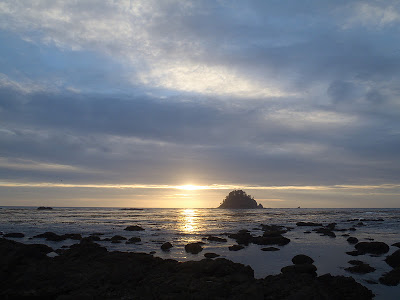 |
| West Quoddy Head, Maine |
Its a bit ironic that the easternmost point in America is named "West Quoddy Head". This is the easternmost part of Maine and therefore it is America's first sunrise. This novelty is what really draws people to this rather isolated part of Maine but the sunrise is beautiful in itself. Its hardly ever that crowded and it sports views of one of Maine's most beloved lighthouse and a classic rugged coastline. I've seen a lot of sunrises in this World and none could ever compare to the one I saw in West Quoddy Head.
Information on West Quoddy Head
 |
| Sunset at Cape Alava, Washington |
While "America's First Sunrise" has become a somewhat well-known location, "America's Last Sunset" is a much more isolated and the true spot is unknown. The Pacific Northwest from Northern California to Washington is almost all at the same longitude and there are several very tall mountains within 100 miles of the coast. Nobody knows or has cared enough to find out when the sun's rays last leave land, but the westernmost point in America could be a good candidate. Located in Olympic National Park on the ocean, Cape Alava is a 6 mile hike. The hike itself plunges deep into the temperate rainforest that is the Pacific Northwest before dumping you out on the shore. A short walk North from here will bring you to... perhaps... the last sunset in America.
Cape Alava: Directions and Information
 |
| Arch Rock, Joshua Tree National Park |
Living near Joshua Tree as a climber is as awesome as a surfer living in Hawaii. There are literally over 10,000 named routes in Joshua Tree and probably a couple hundred new routes being pioneered every year. Although a little sharp, the rock is perfectly stable. Southern Californians spend years trying to climb all the routes in Joshua Tree and it never runs out of possibilities. There also happen to be many options for novice climbers and this is often the first destination for people learning how to climb. I somehow return to J-Tree every year and love just picking out a random route and just climbing away. There are hundreds of guidebooks available and the towns around the park all have an extensive network of climbers and outfitters. Whether you live in So-Cal or a thousand miles away, every rock climber must make a pilgrimage to this destination.
 |
| America's most recognizable mountain landscape |
Well I'm probably not the first to tell you the climbing in the Tetons is amazing, but leaving it out of the 50 greatest adventures would be a travesty. Climbing in the Tetons is perhaps the closest you could get to climbing in Alaska without leaving the lower 48. The Tetons are characterized as having very long, brutal winters and a short climbing season. America's first mountaineering school was founded here and they play one of the most prominent roles in the sport. Grand Teton is an obvious destination for most and it is a technical climb from any approach. Middle Teton is a good option if you're looking for something that only requires class III mountaineering skills but it is still more challenging than the most of the southern Rockies. The Tetons have also become a backcountry skiing destination and expert skiers are known to cross the Tetons in the winter months.
Climbing Middle Teton, Wyoming
 |
| The Inside Passage, Alaska |
It would be a bit of a stretch to say I've kayaked the inside passage in the same way I've kayaked other places across America but I have fond memories of two day trips. The Inside Passage is the shipping route through the Alaskan Panhandle that has become a major destination for tourism. Cruise ships commonly use this route today but kayakers are also frequently seen. The existence of cruise ships should not take anything away from the fact that this is the ultimate wilderness. Parts of the passage are scarcely a half a mile wide while being a thousand feet deep. Other parts are fed by massive glaciers which commonly drop house-sized icebergs into frigid water. The fjords create a serene yet erie landscape that is as dangerous as it is thrilling to kayak through. Wildlife abounds as killer whales use this route more often than anyone. This is one adventure I haven't really done as much as I would like. Someday I hope to kayak the inside passage from Seattle to Skagway.
Read. Plan. Get Out There!





1 Comment
natureintheburbs
November 1, 2011 @ 22:12
You sure have some beautiful photos on your blog!!